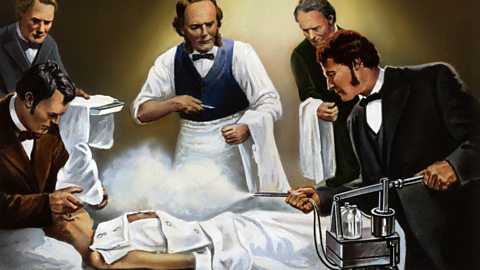Joseph Lister and antiseptic surgery
Following Louis PasteurвҖҷs discovery of germ theory, Joseph Lister found a way to kill germs in an operating theatre. This reduced the risk of infection.
Watch to recap how James Simpson used anaesthetic to combat pain and learn how Joseph Lister used carbolic acid to fight infection.
Infection in surgery
Before PasteurвҖҷs germ theory and the development of antisepticA substance that kills or stops the growth of germs which cause disease. infection following surgery was a huge risk. Germs could get into wounds during an operation. With no antibioticsSubstances that control the spread of bacteria in the body by killing them or stopping them reproducing. infections were often fatal.
Joseph Lister

Joseph Lister was a Scottish surgeon. He read about PasteurвҖҷs work on germ theory. He experimented using a chemical, carbolic acid, to soak bandages before applying them to a wound. He found that it prevented infection and helped wounds to heal.
Carbolic acid spray started to be used widely in surgery. It would be sprayed from a pump at the side of the operating table. This steriliseTo kill any living organisms, usually microbes that might cause disease, on an object or in a substance. the air and equipment being used in the surgery.
Carbolic acid was hugely effective. Lister reported that mortality rateThe number of deaths in a place (or group) compared with the total number of people in that place (or group). in his surgery fell from 40 per cent before its use to 15 per cent afterwards he started using it. This was a huge step forward in making surgery safer.
Opposition to carbolic acid
Not all surgeons approved of the use of carbolic acid in surgery. Some surgeons complained that the acid irritated their eyes and hands, making it difficult to carry out delicate surgery. Instruments and equipment were soaked in the acid, making them slippery.
Some surgeons found the machine spraying the acid was getting in the way and making it more difficult for them to concentrate.
Aseptic surgery
Further improvements were made to deal with the problems with carbolic acid. An American surgeon, William Halsted, asked a tyre company to make rubber gloves for him to wear during operations. Halsted came up with the idea after speaking to a nurse who had suffered from dry skin on her hands due to the use of carbolic spray. The use of gloves helped to make surgery cleaner and therefore safer.
Halsted went on to encourage aseptic surgery Surgery using precautions to lower the risk of infection from sepsis. The aim was to sterilise equipment and hands, so there were no germs that could cause infection during an operation. This meant there was no need for carbolic acid to be used.
Blood loss
The final major barrier to more complex surgery was blood loss. This problem was solved in 1901 when Karl Landsteiner discovered blood groups. This meant that blood transfusionWhen people are given blood via a drip. could now successfully be carried out. As a result, longer operations were made safer.